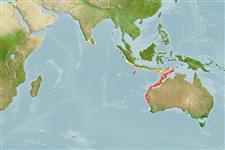Environment: milieu / climate zone / depth range / distribution range
Écologie
marin démersal; profondeur 150 - 280 m (Ref. 27966). Tropical
Eastern Indian Ocean: southern Indonesia and northern Australia.
Taille / Poids / Âge
Maturity: Lm ? range ? - ? cm
Max length : 23.0 cm SL mâle / non sexé; (Ref. 27966)
Rayons mous anaux: 15. Head depressed. Body without large scute-like spines. Infraorbital bones forming a strong ridge, confluent with uppermost preopercular spine and having 4-6 spines (Ref. 40506).
Occurs over soft bottom of the continental shelf and continental slope. Benthic (Ref. 75154).
Life cycle and mating behavior
Maturities | Reproduction | Spawnings | Egg(s) | Fecundities | Larves
Imamura, H. and L.W. Knapp, 1998. Review of the genus Bembras Cuvier, 1929 (Scorpaeniformes: Bembridae) with description of three new species collected from Australia and Indonesia. Ichthyol. Res. 45(2):165-178. (Ref. 27966)
Statut dans la liste rouge de l'IUCN (Ref. 130435)
Menace pour l'homme
Harmless
Utilisations par l'homme
Outils
Articles particuliers
Télécharger en XML
Sources Internet
Estimates based on models
Preferred temperature (Ref.
123201): 14.5 - 20.4, mean 16.7 °C (based on 12 cells).
Phylogenetic diversity index (Ref.
82804): PD
50 = 0.5332 [Uniqueness, from 0.5 = low to 2.0 = high].
Bayesian length-weight: a=0.00389 (0.00180 - 0.00842), b=3.12 (2.94 - 3.30), in cm total length, based on all LWR estimates for this body shape (Ref.
93245).
Niveau trophique (Ref.
69278): 3.7 ±0.4 se; based on size and trophs of closest relatives
Fishing Vulnerability (Ref.
59153): Low vulnerability (18 of 100).
